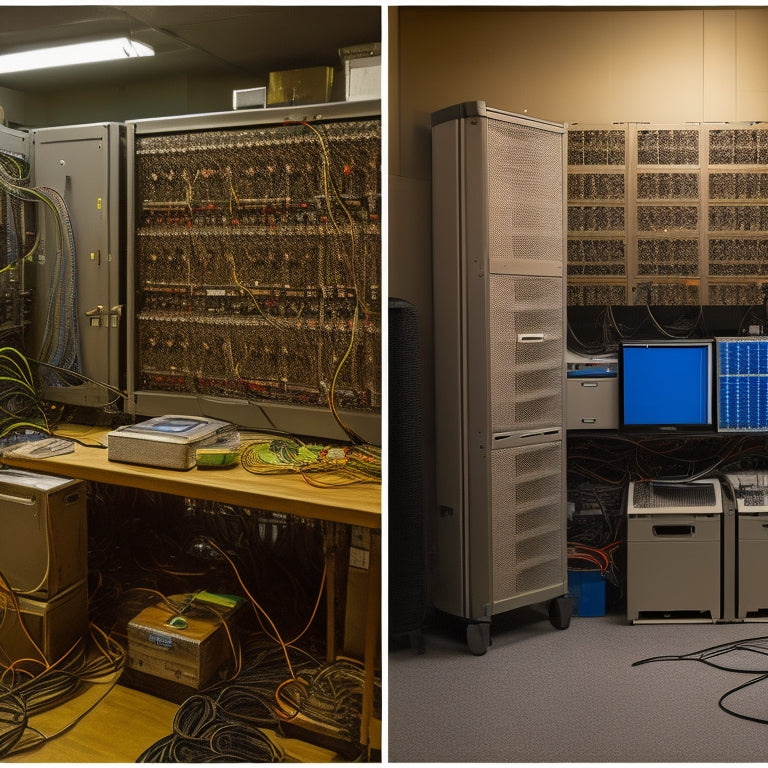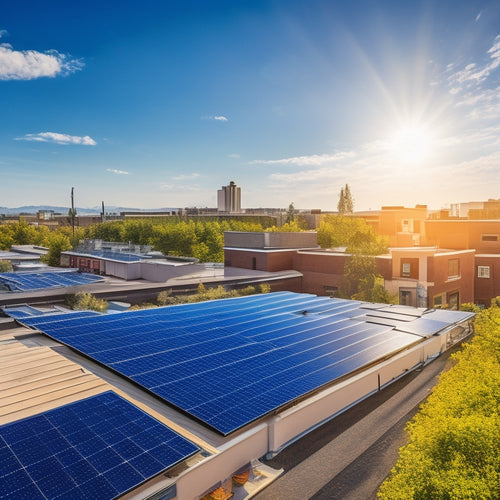
Choosing the Right Commercial Grade Mounting Rails
Share
When choosing commercial grade mounting rails for your solar panel installation, you'll need to take into account several critical factors. Accurate load calculations and structural analysis are crucial to guarantee safe operation and determine the maximum weight capacity of your system. You'll also need to assess rail material options, such as aluminum and steel, taking into account factors like strength, durability, and cost. Additionally, consider the impact of coatings and finishes on performance and longevity, as well as compatibility with your solar panels. By evaluating these key factors, you'll be well on your way to selecting the right mounting rails for your project - and there's more to explore.
Key Takeaways
• Accurate load calculations and structural analysis ensure safe operation and identify weak points in the mounting rail system.
• Material selection (aluminum or steel) depends on project-specific requirements, considering weight capacity, corrosion resistance, and cost.
• Coatings and finishes significantly impact performance and longevity, with options like powder coating, anodizing, and zinc plating offering varying levels of corrosion resistance.
• Compatibility with solar panels is crucial, considering weight, size, and frame type to ensure secure setup and maximize energy harvesting.
• Compliance with building codes, local ordinances, and regulations is essential to avoid costly rework, project cancellation, or fines.
Understanding Load Calculations
When selecting commercial-grade mounting rails, you must accurately calculate the maximum weight your system will bear to guarantee safe and reliable operation. This requires a thorough understanding of the structural analysis of your system, including the weight of the components, the distribution of that weight, and the environmental factors that may affect the system's performance.
You'll need to contemplate the material properties of the mounting rails, such as their strength, stiffness, and durability, to make sure they can withstand the maximum load.
A thorough structural analysis involves calculating the stress and strain on the mounting rails, taking into account factors like torque, tension, and compression. This analysis will help you determine the maximum weight capacity of your system and identify potential weak points that need to be addressed.
Rail Material Options Compared
When choosing commercial grade mounting rails, you'll need to evaluate the material options that best suit your application.
You'll want to assess the pros and cons of aluminum versus steel, taking into account factors like weight capacity, corrosion resistance, and cost.
Aluminum Vs. Steel
When evaluating commercial grade mounting rails, it's crucial to keep in mind the benefits of aluminum and steel, as each material has unique characteristics that can significantly impact the performance and longevity of your installation.
When it comes to aluminum, it's important to take into account its advantages, including a lower cost compared to steel, making it an appealing option for budget-conscious projects. Additionally, aluminum rails are often preferred for their aesthetic appeal, as they can be anodized to provide a sleek, modern finish.
On the other hand, steel rails offer exceptional strength and durability, making them ideal for heavy-duty applications.
Here are some key differences to take into account:
-
Cost analysis: Aluminum rails are generally more cost-effective, while steel rails are more expensive.
-
Weight capacity: Steel rails can support heavier loads, making them suitable for demanding installations.
-
Corrosion resistance: Aluminum rails are more resistant to corrosion, reducing the need for additional coatings or finishes.
Ultimately, your choice between aluminum and steel mounting rails will depend on your project's specific requirements and priorities.
Coatings and Finishes
Your rail material selection is only the first step, as the chosen coating or finish can greatly impact the performance and longevity of your installation. The right coating or finish can enhance corrosion resistance, aesthetic appeal, and overall durability. When selecting a coating or finish, consider the environment in which your mounting rails will be installed.
| Coating/Finish | Characteristics |
|---|---|
| Powder Coating | Durable, chip-resistant, and corrosion-resistant; ideal for high-traffic areas |
| Anodizing | Enhances corrosion resistance, wear resistance, and aesthetic appeal; suitable for harsh environments |
| Zinc Plating | Offers excellent corrosion resistance, especially in humid or salty environments |
| E-Coating | Provides a smooth, uniform finish, and excellent corrosion resistance |
| Chrome Plating | Enhances aesthetic appeal, corrosion resistance, and wear resistance; ideal for high-end applications |
When choosing a coating or finish, consider factors such as the level of corrosion resistance required, the desired aesthetic appeal, and the environmental conditions in which the mounting rails will be installed. By selecting the appropriate coating or finish, you can ensure that your mounting rails perform at their best and maintain their appearance over time.
Structural Integrity Factors
During the installation process, commercial grade mounting rails undergo various types of stress, and their structural integrity is put to the test. You want to make sure that the rails you choose can withstand harsh environmental conditions, including extreme temperatures, humidity, and exposure to corrosive substances.
When evaluating the structural integrity of commercial grade mounting rails, consider the following key factors:
-
Corrosion resistance: Look for rails with a durable coating or finish that can resist corrosion, ensuring a longer lifespan and reduced maintenance needs.
-
Installation methods: The method of installation can have a notable impact on the structural integrity of the rails. Make sure that the installation method you choose is compatible with the rail's design and material.
-
Material strength: The strength and durability of the rail material itself are crucial to its structural integrity. Choose rails made from high-strength, durable materials that can withstand various types of stress.
Compatibility With Solar Panels
When selecting commercial grade mounting rails for your solar panel installation, it's important to verify compatibility between the rails and the solar panels to guarantee peak energy harvesting and a secure setup. You want to confirm that the rails can support the weight and size of your solar panels, while also allowing for easy installation and maintenance.
Incompatible rails can lead to reduced solar efficiency, causing you to lose out on valuable energy production.
To achieve ideal panel integration, consider the following factors: panel size, weight, and frame type. Confirm the mounting rails are designed specifically for your panel's frame type, whether it's a standard or slim frame. You should also check the rail's weight capacity to ensure it can support the combined weight of the panels.
Additionally, look for rails with built-in features that facilitate easy installation and wiring management, such as cable ties and clips. By prioritizing compatibility, you'll be able to maximize your solar efficiency and enjoy a secure, hassle-free installation.
Adjustability and Flexibility Needs
Commercial grade mounting rails must provide adjustability and flexibility to accommodate various roof types, angles, and environmental conditions, guaranteeing a secure and efficient solar panel installation.
As you evaluate different mounting rail systems, consider the following key aspects of adjustability and flexibility:
-
Customization options: Look for systems that offer adjustable clamps, sliding brackets, and telescoping rails to guarantee a snug fit on diverse roof structures and angles.
-
Mounting precision: Opt for systems with built-in leveling features and micro-adjustments to guarantee precise alignment and secure fastening of solar panels.
-
System scalability: Choose a system that allows for easy expansion or reconfiguration as your solar panel array grows or changes.
Compliance With Building Codes
When selecting commercial grade mounting rails, you need to guarantee compliance with building codes and local ordinances that apply to your installation. You must familiarize yourself with the relevant codes and regulations that govern your project, as failure to adhere can result in costly rework or even project cancellation.
Code Requirements
You must make certain that your mounting rail system complies with relevant building codes and regulations, which vary by region and jurisdiction. Failure to comply can result in costly rework, fines, or even project shutdowns. To guarantee compliance, it's crucial to understand the specific codes and regulations governing your project.
Here are three key considerations:
-
Fire Safety: Your mounting rail system must meet fire safety standards, including flammability and smoke emission requirements.
-
Building Permits: Obtain necessary permits and approvals before commencing installation to avoid delays or penalties.
-
Regional Variations: Familiarize yourself with local building codes, which may differ significantly from national or international standards.
Local Ordinances Apply
In addition to meeting national or international building codes, your mounting rail system must also abide by local ordinances that may impose stricter or more specific requirements.
As you navigate the complex world of commercial grade mounting rails, it's crucial to take into account the local regulations that govern your project. Zoning regulations, for instance, may dictate the type of materials or design elements you can use, while permit requirements may vary depending on the jurisdiction.
You'll need to research and understand the local ordinances that apply to your specific project, taking into account factors like environmental impact, noise levels, and aesthetics. Failure to comply with local ordinances can result in costly delays, fines, or even project cancellation.
Frequently Asked Questions
Can I Use Residential-Grade Mounting Rails for Commercial Projects?
You shouldn't use residential-grade mounting rails for commercial projects, as they often can't handle heavy load capacities and may not meet code compliance, putting your entire installation at risk of failure and safety hazards.
How Do I Determine the Correct Rail Size for My Solar Panel Array?
When building a solar array, you're constructing a skyscraper for your panels; just as a strong foundation is important, you must guarantee your rails are sized correctly to maintain structural integrity. Measure your panel dimensions carefully to get it right.
Are Anodized Aluminum Rails More Durable Than Mill Finish Aluminum?
When comparing anodized aluminum rails to mill finish aluminum, you'll find anodized rails offer superior corrosion resistance and weather endurance, making them a more durable option for your solar panel array.
Can I Mix and Match Components From Different Manufacturers?
When mixing and matching components from different manufacturers, you'll face compatibility issues, potentially voiding manufacturer warranties, so verify compliance with industry standards to avoid integration headaches and maintain system reliability.
Do Commercial-Grade Mounting Rails Require Special Installation Tools?
When you venture into commercial-grade mounting rail installations, you'll likely need specialized tools to meet precise torque requirements, ensuring secure fastening and organized cable management - don't get stuck, invest in the right gear for a hassle-free setup.
Related Posts
-

How Solar Panels Increase Property Value
Installing solar panels considerably increases your property value by improving energy efficiency and attracting eco-...
-

Home Solar Systems for Environmental Impact
Home solar systems markedly reduce your carbon footprint by utilizing renewable energy. By adopting solar energy, you...
-

Solar Energy Solutions for Small Businesses
Switching to solar energy can be a game changer for your small business. You'll enjoy significant cost savings on mon...


